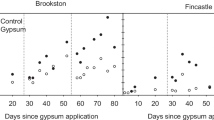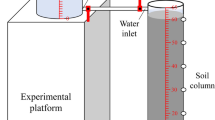Abstract
Purpose
The effectiveness of gypsum in sodic soil amelioration has been widely recognized. The basic amelioration mechanism is well known, but quantitative details are lacking; such details would clarify the process so that gypsum can be used more rationally and efficiently in actual amelioration projects of sodic land.
Materials and methods
Sodic soil with pH, electrical conductivity (EC), exchangeable sodium percentage (ESP) and sodium adsorption ratio (SAR) values of 9.4, 0.66 mS cm–1, 43.3% and 58.6 (mmolc L−1)1/2, respectively, was sampled from the Songnen Plain. Three gypsum solutions with concentrations of 0 (CK), 1.13 (half-saturated solution; 1/2GS) and 2.26 g L–1 (saturated solution; GS) were used to leach sodic soil columns (inner diameter and depth were all 5 cm) and the variations in pH, EC and ion concentration in the leachate and soil were investigated.
Results and discussion
The eluent appeared at the bottom of the soil column after 1.8, 64.4 and 147.6 h for the GS, 1/2GS, and CK treatments, respectively. The rates of infiltration and salt leaching at a given time were always faster in the GS treatment, followed by the 1/2GS treatment. In the GS leachate, the curves of infiltration rate, pH, EC and HCO3– concentration with the cumulative volume of leachate all showed turning points at a leachate pore volume (PV) of 0.6. As leaching continued, Ca–Na exchange, followed by Ca–Mg exchange, occurred in the gypsum-treated soil. The Ca2+ utilization rate was 96.5% and 94.4% in the GS and 1/2GS treatments, respectively, in the period of Ca–Na exchange, and the rate during Ca–Mg exchange was higher in the 1/2GS than the GS treatment. When the cumulative leachate volume reached 18 and 20 PV in the GS and 1/2GS treatments, respectively, the leachate EC and pH values were stable (the errors of three consecutive leachate samples were all within 0.5% and 0.5, respectively; equilibrium state). In the gypsum treatments, the soil pH, SAR and ESP decreased by more than 1.5 units, 13.8 (mmolc L−1)1/2 and 22.3%, respectively, compared to CK.
Conclusions
To achieve rapid amelioration, efficient utilization of Ca2+, and reduced water consumption, it is suggested that the initial gypsum application rate for sodic soil amelioration be calculated on the basis of the exchangeable Na+ concentration and combined with appropriate water measures to maintain a high concentration of gypsum solution, followed by multiple applications of small amounts to create a low-concentration gypsum solution environment to reduce Mg2+.






Similar content being viewed by others
Data availability
All data supporting to this work is available in this article.
References
Adeyemo T, Kramer I, Levy GJ, Mau Y (2022) Salinity and sodicity can cause hysteresis in soil hydraulic conductivity. Geoderma 413:115765
Alam Q, Lazaro A, Schollbach K, Brouwers HJH (2020) Chemical speciation, distribution and leaching behavior of chlorides from municipal solid waste incineration bottom ash. Chemosphere 241:124985
Amini S, Ghadiri H, Chen C, Marschner P (2015) Salt-affected soils, reclamation, carbon dynamics, and biochar: a review. J Soils Sediments 16:939–953
Armstrong ASB, Tanton TW (1992) Gypsum applications to aggregated saline-sodic clay topsoils. J Soil Sci 43:249–260
Bagarello V, Iovino M, Palazzolo E, Panno M, Reynolds WD (2006) Field and laboratory approaches for determining sodicity effects on saturated soil hydraulic conductivity. Geoderma 130:1–13
Bao S (2008) Soil agro-chemistrical analysis (III). China Agriculture Press, Beijing
Bhardwaj AK, Mishra VK, Singh AK, Arora S, Srivastava S, Singh YP, Sharma DK (2019) Soil salinity and land use-land cover interactions with soil carbon in a salt-affected irrigation canal command of Indo-Gangetic plain. CATENA 180:392–400
Chi CM, Zhao CW, Sun XJ, Wang ZC (2012) Reclamation of saline-sodic soil properties and improvement of rice (Oriza sativa L.) growth and yield using desulfurized gypsum in the west of Songnen Plain, northeast China. Geoderma 187–188:24–30
Deng M, Liu Q, Xu Z (2013) Impact of gypsum supersaturated solution on surface properties of silica and sphalerite minerals. Miner Eng 46–47:6–15
Diamantis VI, Voudrias EA (2008) Laboratory and pilot studies on reclamation of a salt-affected alluvial soil. Environ Geol 54:643–651
East China University of Science and Technology, Sichuan University (2018) Analytical chemistry, 7th edn. Higher Education Press, Beijing
FAO-Unesco (1997) Soil Map of the World, Revised Legend. ISRIC, Wageningen
Farooq M, Hussain M, Wakeel A, Siddique KHM (2015) Salt stress in maize: effects, resistance mechanisms, and management. A Review. Agron Sustain Dev 35:461–481
Fei Y, She D, Gao L, Xin P (2019) Micro-CT assessment on the soil structure and hydraulic characteristics of saline/sodic soils subjected to short-term amendment. Soil till Res 193:59–70
Hernández-López MF, Gironás J, Braud I, Suárez F, Muñoz JF (2014) Assessment of evaporation and water fluxes in a column of dry saline soil subject to different water table levels. Hydrol Process 28:3655–3669
Johannes A, Weisskopf P, Schulin R, Boivin P (2019) Soil structure quality indicators and their limit values. Ecol Indic 104:686–694
Karnland O, Birgersson M, Hedström M (2011) Selectivity coefficient for Ca/Na ion exchange in highly compacted bentonite. Phys Chem Earth 36:1554–1558
Kong X, Jiang X, Xue S, Huang L, Hartley W, Wu C, Li X (2018) Migration and distribution of saline ions in bauxite residue during water leaching. Trans Nonferrous Met Soc China 28:534–541
Kopittke PM, So HB, Menzies NW (2006) Effect of ionic strength and clay mineralogy on Na-Ca exchange and the SAR-ESP relationship. Eur J Soil Sci 57:626–633
Koralegedara NH, Pinto PX, Dionysiou DD, Al-Abed SR (2019) Recent advances in flue gas desulfurization gypsum processes and applications - a review. J Environ Manag 251:109572
Li H, Wei J, Ge Y, Wang Z, Wang Y, Li Y (2016) The influence of Na+ and Ca2+ on the migration of colloids or/and ammonia nitrogen in an unsaturated zone medium. J Contam Hydrol 194:24–29
Liao R, Yu H, Yang P, Lin H (2020) Quantitative evaluation of pore characteristics of sodic soils reclaimed by flue gas desulphurization gypsum using X-ray computed tomography. Land Degrad Dev 31:545–556
Mao Y, Li X, Dick WA, Chen L (2016) Remediation of saline-sodic soil with flue gas desulfurization gypsum in a reclaimed tidal flat of southeast China. J Environ Sci 45:224–232
Mukhopadhyay R, Sarkar B, Jat HS, Sharma PC, Bolan NS (2021) Soil salinity under climate change: challenges for sustainable agriculture and food security. J Environ Manag 280:111736
Rabot E, Wiesmeier M, Schlüter S, Vogel HJ (2018) Soil structure as an indicator of soil functions: a review. Geoderma 314:122–137
Richards LA (1954) Diagnosis and improvement of saline and alkali soils. US Salinity Laboratory Staff, Washington DC
Schofield S, Jankowski J (2004) Hydrochemistry and isotopic composition of Na–HCO3-rich groundwaters from the Ballimore region, central New South Wales, Australia. Chem Geol 211:111–134
Shainberg I, Caiserman A (1970) Studies on Na/Ca montmorillonite systems 2. The hydraulic conductivity. Soil Sci 111:276–281
Skyllberg U, Raulund-Rasmussen K, Borggaard OK (2001) pH buffering in acidic soils developed under Picea abies and Quercus robur – effects of soil organic matter, adsorbed cations and soil solution ionic strength. Biogeochem 56:51–74
Sundha P, Basak N, Rai AK, Yadav RK, Sharma PC, Sharma DK (2020) Can conjunctive use of gypsum, city waste composts and marginal quality water rehabilitate saline-sodic soils? Soil till Res 200:104608
Tanton TW, Rycroft DW, Wilkinson FM (1988) The leaching of salts from saline heavy clay soils: factors affecting the leaching process. Soil Use Manag 4:133–140
Temiz C, Cayci G (2018) The effects of gypsum and mulch applications on reclamation parameters and physical properties of an alkali soil. Environ Monit Assess 190:346–358
Tirado-Corbalá R, Slater BK, Dick WA, Bigham J, McCoy E (2013) Hydrologic properties and leachate nutrient responses of soil columns collected from gypsum-treated fields. Soil till Res 134:232–240
Torkzaban S, Bradford SA, Vanderzalm JL, Patterson BM, Harris B, Prommer H (2015) Colloid release and clogging in porous media: Effects of solution ionic strength and flow velocity. J Contam Hydrol 181:161–171
Wang J, Bai Z, Yang P (2016) Using HYDRUS to simulate the dynamic changes of Ca2+ and Na+ in sodic soils reclaimed by gypsum. Soil Water Res 11:1–10
Wang JM, Bai ZK, Yang PL (2014) Mechanism and numerical simulation of multicomponent solute transport in sodic soils reclaimed by calcium sulfate. Environ Earth Sci 72:157–169
Wang SJ, Chen Q, Li Y, Zhuo YQ, Xu LZ (2017) Research on saline-alkali soil amelioration with FGD gypsum. Resour Conserv Recycl 121:82–92
Wang Y, Wang Z, Liang F, Jing X, Feng W (2021) Application of flue gas desulfurization gypsum improves multiple functions of saline-sodic soils across China. Chemosphere 277:130345
Weil RR, Brady NC (2016) The nature and properties of soils. Pearson, London
Wong VNL, Greene RSB, Dalal RC, Murphy BW (2010) Soil carbon dynamics in saline and sodic soils: a review. Soil Use Manage 26(1):2–11
Yazdanpanah N, Mahmoodabadi M (2013) Reclamation of calcareous saline–sodic soil using different amendments: time changes of soluble cations in leachate. Arab J Geosci 6:2519–2528
Zhang L, Ge AH, Tóth T, Yang F, Wang Z, An F (2023) Reclamation effects of distinct volumes and concentrations of CaCl2-amended brackish ice in different saline-sodic soils. J Environ Manag 337:117748
Zhang W, Zhang W, Wang S, Liu J, Li Y, Zhuo Y, Xu L, Zhao Y (2021a) Band application of flue gas desulfurization gypsum improves sodic soil amelioration. J Environ Manag 298:113535
Zhang W, Zhao Y, Wang S, Li Y, Zhuo Y, Liu J (2021b) Soil salinity and sodicity changes after a one-time application of flue gas desulphurization gypsum to paddy fields. Land Degrad Dev 32:4193–4202
Zhang XC, Norton LD (2002) Effect of exchangeable Mg on saturated hydraulic conductivity, disaggregation and clay dispersion of disturbed soils. J Hydrol 260:194–205
Zhao Y, Zhang W, Wang S, Liu J, Li Y, Zhuo Y (2020) Effects of soil moisture on the reclamation of sodic soil by flue gas desulfurization gypsum. Geoderma 375:114485
Zhao YG, Wang SJ, Li Y, Liu J, Zhuo YQ, Chen HX, Wang J, Xu LZ, Sun ZT (2018) Extensive reclamation of saline-sodic soils with flue gas desulfurization gypsum on the Songnen Plain, Northeast China. Geoderma 321:52–60
Zhou D, Wang D, Cang L, Hao X, Chu L (2011) Transport and re-entrainment of soil colloids in saturated packed column: effects of pH and ionic strength. J Soils Sediments 11:491–503
Zhu P, Zhang G, Zhang B (2022) Soil saturated hydraulic conductivity of typical revegetated plants on steep gully slopes of Chinese Loess Plateau. Geoderma 412:115717
Zhuang J, Tyner JS, Perfect E (2009) Colloid transport and remobilization in porous media during infiltration and drainage. Hydrol J 377:112–119
Funding
This research was supported by the National Key Research and Development Program of China (2022YFD1500502).
Author information
Authors and Affiliations
Corresponding author
Ethics declarations
Competing interest
The authors declare that they have no conflicts of interest.
Additional information
Responsible editor: Claudio Colombo
Publisher's Note
Springer Nature remains neutral with regard to jurisdictional claims in published maps and institutional affiliations.
Wenchao Zhang and Wenxin Zhang contributed equally to this article as first authors.
Supplementary Information
Below is the link to the electronic supplementary material.
Rights and permissions
Springer Nature or its licensor (e.g. a society or other partner) holds exclusive rights to this article under a publishing agreement with the author(s) or other rightsholder(s); author self-archiving of the accepted manuscript version of this article is solely governed by the terms of such publishing agreement and applicable law.
About this article
Cite this article
Zhang, W., Zhang, W., Wang, S. et al. A quantitative assessment of the dynamic process and potential capacity of using gypsum to reclaim sodic soil. J Soils Sediments 23, 3082–3095 (2023). https://doi.org/10.1007/s11368-023-03535-6
Received:
Accepted:
Published:
Issue Date:
DOI: https://doi.org/10.1007/s11368-023-03535-6




